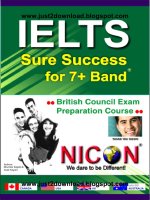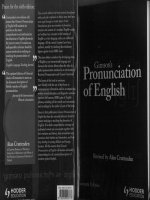Reading comprehension success part 1 ppsx
Bạn đang xem bản rút gọn của tài liệu. Xem và tải ngay bản đầy đủ của tài liệu tại đây (81.18 KB, 10 trang )
READING
COMPREHENSION
SUCCESS
IN 20 MINUTES A DAYNEW YORK
READING
COMPREHENSION
SUCCESS
IN 20 MINUTES A DAY
3rd Edition
®
Copyright © 2005 LearningExpress, LLC.
All rights reserved under International and Pan-American Copyright Conventions.
Published in the United States by LearningExpress, LLC, New York.
Library of Congress Cataloging-in-Publication Data:
Reading comprehension success in 20 minutes a day.—3rd ed.
p. cm.
ISBN 1-57685-494-9 (paper)
1. Reading comprehension—Problems, exercises, etc. I. Title. II. Title: Reading
comprehension success in twenty minutes a day.
LB1050.45.C45 2005
428.4—dc22
2005047184
Printed in the United States of America
9 8 7 6 5 4 3 2 1
Third Edition
For information on LearningExpress, other LearningExpress products, or bulk sales, please write to us at:
LearningExpress
55 Broadway
8th Floor
New York, NY 10006
Or visit us at:
www.learnatest.com
INTRODUCTION How to Use This Book ix
PRETEST 1
BUILDING A STRONG FOUNDATION
LESSON 1 Getting the Essential Information 19
How to be an active reader, picking up clues in what you read
LESSON 2 Finding the Main Idea 27
Looking beyond the facts, considering the author’s motive
LESSON 3 Defining Vocabulary in Context 33
Dealing with unfamiliar words without a dictionary
LESSON 4 The Difference between Fact and Opinion 39
Distinguishing between what an author knows and what an author
believes to be true
LESSON 5 Putting It All Together 45
Practice in combining the skills you’ve learned in Lessons 1–4
Contents
v
STRUCTURE
LESSON 6 Start from the Beginning: Chronological Order 53
Working through passages that start at the beginning and finish at the end
of a sequence of events
LESSON 7 Order of Importance 61
Using the order in the writing to determine what is most important to the author
LESSON 8 Similarities and Differences: Compare and Contrast 67
Using comparisons to determine the author’s attitude
LESSON 9 Why Do Things Happen? A Look at Cause and Effect 73
The relationship between action and reaction
LESSON 10 Being Structurally Sound: Putting It All Together 81
Reviews Lessons 6–9, including identifying the structure used;
practice with combined structures
LANGUAGE AND STYLE
LESSON 11 A Matter of Perspective: Point of View 89
Purposes of first-, second-, and third-person writing
LESSON 12 Diction: What’s in a Word? 95
Defining tone from the choice of words
LESSON 13 Style: It’s Not What They Say but How They Say It 101
Sentence structure; degree of detail, description, and formality
LESSON 14 How They Say It, Part Two: Tone 107
How tone influences meaning
LESSON 15 Word Power: Putting It All Together 111
Reviews Lessons 11–14
READING BETWEEN THE LINES
LESSON 16 Finding the Implied Main Idea 119
Making inferences, determining an unstated purpose
LESSON 17 Assuming Causes and Predicting Effects 125
Reading between the lines, implied action and reaction
LESSON 18 Emotional Versus Logical Appeals 131
Being aware of strong and weak arguments
– CONTENTS–
vi
LESSON 19 Finding Meaning in Literature 137
Identifying themes, working with poetry
LESSON 20 Drawing Conclusions: Putting It All Together 143
Reviews Lessons 1–19
POSTTEST 149
APPENDIX A Preparing for a Standardized Test 169
APPENDIX B Additional Resources 175
– CONTENTS–
vii
his book is designed to help you improve your reading comprehension skills by studying 20 minutes
a day for 20 days. You’ll start with the basics and move on to more complex reading comprehension
and critical thinking strategies. Please note that although each chapter can be an effective skill builder
on its own, it is important that you proceed through this book in order, from Lesson 1 through Lesson 20. Each
lesson builds on skills and ideas discussed in the previous chapters. As you move through this book and your read-
ing skills develop, the passages you read will increase both in length and in complexity.
The book begins with a pretest, which will allow you to see how well you can answer various kinds of read-
ing comprehension questions now, as you begin. When you finish the book, take the posttest to see how much
you’ve improved.
The text is divided into four sections, each focusing on a different group of related reading and thinking strate-
gies. These strategies will be outlined at the beginning of each section and then reviewed in a special “putting it
all together” final lesson.
Each lesson provides several exercises that allow you to practice the skills you learn. To ensure you’re on the
right track, each lesson also provides answers and explanations for all of the practice questions. Additionally, you
will find practical suggestions in each chapter for how to continue practicing these skills in your daily life.
The most important thing you can do to improve your reading skills is to become an active reader. The fol-
lowing guidelines and suggestions outlined will familiarize you with active reading techniques. Use these techniques
as much as possible as you work your way through the lessons in this book.
How to Use This Book
ix
Becoming an Active Reader
Critical reading and thinking skills require active read-
ing. Being an active reader means you have to engage
with the text, both mentally and physically.
■
Skim ahead and jump back.
■
Mark up the text.
■
Make specific observations about the text.
Skimming Ahead and Jumping Back
Skimming ahead enables you to see what’s coming up
in your reading. Page through the text you’re about to
read. Notice how the text is broken down, what the
main topics are, and the order in which they are cov-
ered. Notice key words and ideas that are boldfaced,
bulleted, boxed, or otherwise highlighted. Skimming
through the text beforehand will prepare you for what
you are about to read. It’s a lot like checking out the hills
and curves in the course before a cross-country race. If
you know what’s ahead, you know how to pace your-
self, so you’re prepared to handle what’s to come.
When you finish your reading, jump back. Review
the summaries, headings, and highlighted informa-
tion in the text. Notice both what the author high-
lighted and what you highlighted. By jumping back,
you help solidify in your mind the ideas and informa-
tion you just read. You’re reminded of how each idea fits
into the whole, how ideas and information are con-
nected. When you make connections between ideas,
you’re much more likely to remember them.
Marking Up the Text
Marking up the text creates a direct physical link
between you and the words you’re reading. It forces you
to pay closer attention to the words you read and takes
you to a higher level of comprehension. Use these three
strategies to mark up text:
1. Highlight or underline key words and ideas.
2. Circle and define any unfamiliar words or
phrases.
3. Record your reactions and questions in the
margins.
Highlighting or Underlining Key Ideas
When you highlight or underline key words and ideas,
you are identifying the most important parts of the text.
There’s an important skill at work here: You can’t high-
light or underline everything, so you have to distinguish
between the facts and ideas that are most important
(major ideas) and those facts and ideas that are help-
ful but not so important (minor or supporting ideas).
Highlight only the major ideas, so you don’t end up
with a text that’s completely highlighted.
An effectively highlighted text will make for an
easy and fruitful review. When you jump back, you’ll be
quickly reminded of the ideas that are most important
to remember. Highlighting or underlining major points
as you read also allows you to retain more information
from the text.
Circling Unfamiliar Words
One of the most important habits to develop is that of
circling and looking up unfamiliar words and phrases.
If possible, don’t sit down to read without a dictionary
by your side. It is not uncommon for the meaning of an
entire sentence to hinge on the meaning of a single
word or phrase, and if you don’t know what that word
or phrase means, you won’t understand the sentence.
Besides, this habit enables you to quickly and steadily
expand your vocabulary, so you’ll be a more confident
reader and speaker.
If you don’t have a dictionary readily available, try
to determine the meaning of the word as best you can
from its context—that is, the words and ideas around
it. (There’s more on this topic in Lesson 3.) Then, make
sure you look up the word as soon as possible so you’re
sure of its meaning.
– HOW TO USE THIS BOOK–
x









